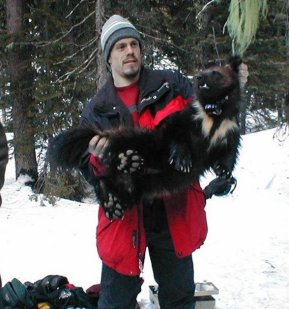The series of public meetings on the planning rulemaking process starts with a science forum next Monday and Tuesday (March 29-30) in Washington D.C. The draft agenda has five panels over the two day event. The event will be webcast. Here is information on the panels and panelists with their web links. The panels are a mix of academia and Forest Service researchers, private consultants and non-governmental organizations.
Panel 1: Drivers of Ecosystems This panel will discuss the ecological processes that function at the landscape scale across multiple ownerships and suggest ways that the planning rule might better consider these processes.
Tom Sisk – Topic: Landscape Ecology and Land Use Patterns
 Tom Sisk is Director of the Lab of Landscape Ecology and Conservation Biology at Northern Arizona Univ. His areas of research interest and expertise include ecology, conservation biology, landscape design; land use and environmental policy; collaborative management and democratic process in land and resource management, and; biocultural conservation on the Colorado Plateau and across western North America.
Tom Sisk is Director of the Lab of Landscape Ecology and Conservation Biology at Northern Arizona Univ. His areas of research interest and expertise include ecology, conservation biology, landscape design; land use and environmental policy; collaborative management and democratic process in land and resource management, and; biocultural conservation on the Colorado Plateau and across western North America.
Jim Vose – Topic: Watershed Science
 Jim Vose is Project Leader of the Forest Service Coweeta Hydrologic Laboratory in Otto, NC. His current research emphasis has been on phytoremediation of groundwater pollutants, riparian zone restoration, forest carbon, nutrient, and water cycling, modeling of biological systems, fire ecology and restoration of fire dependent ecosystems, old-growth structure and function.
Jim Vose is Project Leader of the Forest Service Coweeta Hydrologic Laboratory in Otto, NC. His current research emphasis has been on phytoremediation of groundwater pollutants, riparian zone restoration, forest carbon, nutrient, and water cycling, modeling of biological systems, fire ecology and restoration of fire dependent ecosystems, old-growth structure and function.
Connie Millar – Topic: Climate Change and Forest Ecosystems
 Connie Millar is a Research Paleoecologist at the Forest Service Pacific Southwest Research Station. Her research interest is the integration of science with policy at the ecoregional and interdisciplinary scale. She is especially interested in communicating and interpreting current research on climate change and its ecological effects in conservation and restoration contexts.
Connie Millar is a Research Paleoecologist at the Forest Service Pacific Southwest Research Station. Her research interest is the integration of science with policy at the ecoregional and interdisciplinary scale. She is especially interested in communicating and interpreting current research on climate change and its ecological effects in conservation and restoration contexts.
Max Moritz – Topic: Fire
 Max Moritz is a Cooperative Extension Specialist and a wildland fire expert at UC Berkeley. Much of his research is focused on understanding the dynamics of fire regimes at relatively broad scales and using this information in ecosystem management. He employs quantitative analyses of fire history, examining the relative importance of different mechanisms that drive fire patterns on the landscape. Also he is interested in simulation of fire dynamics, using spatially-explicit models of fire spread and vegetation regrowth.
Max Moritz is a Cooperative Extension Specialist and a wildland fire expert at UC Berkeley. Much of his research is focused on understanding the dynamics of fire regimes at relatively broad scales and using this information in ecosystem management. He employs quantitative analyses of fire history, examining the relative importance of different mechanisms that drive fire patterns on the landscape. Also he is interested in simulation of fire dynamics, using spatially-explicit models of fire spread and vegetation regrowth.
Panel 2: Panelists will discuss current science as it relates to planning, managing, monitoring, and adapting at the landscape scale and explore ways that a planning rule could address these topics.
Eric Gustafson – Topic: Projecting Impacts of Management Alternatives
 Eric Gustafson is a Forest Service Project Leader and Research Landscape Ecologist at the Institute for Applied Ecosystem Studies. His current research focuses on timber harvest simulation (HARVEST), which allows scientists to simulate timber management strategies in a spatially explicit manner through time. He uses HARVEST to study the cumulative effects of the various objectives of multiple landowners across an entire landscape. He helped develop the LANDIS forest succession and disturbance model, and he is working with other scientists to study the interactions among human and natural disturbances to determine the risk of wildfire within large landscapes.
Eric Gustafson is a Forest Service Project Leader and Research Landscape Ecologist at the Institute for Applied Ecosystem Studies. His current research focuses on timber harvest simulation (HARVEST), which allows scientists to simulate timber management strategies in a spatially explicit manner through time. He uses HARVEST to study the cumulative effects of the various objectives of multiple landowners across an entire landscape. He helped develop the LANDIS forest succession and disturbance model, and he is working with other scientists to study the interactions among human and natural disturbances to determine the risk of wildfire within large landscapes.
Steve McNulty – Topic: Water and Climate Change at the Landscape Level
 Steve McNulty is a Forest Service Research Ecologist with the Southern Research Station. His current research includes regional to continental scale forest modeling including forest hydrology, productivity, resource economics, and wildlife and forest diversity. Emphasis is given to model interactions and response of forests to global climate change and other environmental stresses including ozone, nitrogen deposition, and atmospheric CO2.Other research includes the influence of forest management practices on forest hydrology, productivity, and spatially explicit soil erosion.
Steve McNulty is a Forest Service Research Ecologist with the Southern Research Station. His current research includes regional to continental scale forest modeling including forest hydrology, productivity, resource economics, and wildlife and forest diversity. Emphasis is given to model interactions and response of forests to global climate change and other environmental stresses including ozone, nitrogen deposition, and atmospheric CO2.Other research includes the influence of forest management practices on forest hydrology, productivity, and spatially explicit soil erosion.
B. Ken Williams – Topic: Adaptive Management
Ken Williams is the Chief of the USGS Cooperative Research Units. He is an author of numerous publications on analysis and management of animal populations and conservation and on adaptive management.
Sam Cushman – Topic: Quantitative Landscape Ecology

Sam Cushman is a Forest Service Research Landscape Ecologist with the Forest and Woodlands Ecosystems Program at the Rocky Mountain Research Station. His current research includes integrated landscape modeling, biological diversity, and quantitative ecology.
Panel 3: Panelists will talk about the current science behind planning for, managing to maintain and restore, and monitoring plant and animal diversity.
Kevin McKelvey – Topic: Quantification of Diversity
 Kevin McKelvey is a Forest Service Monitoring and Disturbance Ecology Team Leader with the Wildlife Ecology Research Unit at the Rocky Mountain Research Station. Recent focus is on developing methods to evaluate status and trends of organisms across broad spatial and temporal domains. This includes methods to non-invasively survey fisher, marten, cougar, and Canada lynx. Because many population metrics are extremely sensitive to genotyping errors his team has developed cost effective methods to remove errors from genetic samples.
Kevin McKelvey is a Forest Service Monitoring and Disturbance Ecology Team Leader with the Wildlife Ecology Research Unit at the Rocky Mountain Research Station. Recent focus is on developing methods to evaluate status and trends of organisms across broad spatial and temporal domains. This includes methods to non-invasively survey fisher, marten, cougar, and Canada lynx. Because many population metrics are extremely sensitive to genotyping errors his team has developed cost effective methods to remove errors from genetic samples.
Marilyn Stoll – Topic: Endangered Species
 Marilyn Stoll is a Senior Biologist with the Fish and Wildlife Service Everglades Restoration Program. She provides technical advice to DOI leadership on Endangered Species Act compliance, Fish and Water Coordination Act activities, Clean Water Act compliance and Migratory Bird Treaty Act action. Previously she served as a supervisory biologist in FWS in Florida managing Everglades Restoration projects and in Washington (state) as the supervisory team lead for FWS on the Northwest Forest Plan (Olympic Penninsula and Washington Cascades Teams). She has worked for USDA Forest Service NFS, International Programs, and R&D on projects like FEMAT, Spotted Owl, Fisher, and Puerto Rican parrot.
Marilyn Stoll is a Senior Biologist with the Fish and Wildlife Service Everglades Restoration Program. She provides technical advice to DOI leadership on Endangered Species Act compliance, Fish and Water Coordination Act activities, Clean Water Act compliance and Migratory Bird Treaty Act action. Previously she served as a supervisory biologist in FWS in Florida managing Everglades Restoration projects and in Washington (state) as the supervisory team lead for FWS on the Northwest Forest Plan (Olympic Penninsula and Washington Cascades Teams). She has worked for USDA Forest Service NFS, International Programs, and R&D on projects like FEMAT, Spotted Owl, Fisher, and Puerto Rican parrot.
Gary Morishima – Topic: All Lands Approach to Maintaining Diversity
 Gary Morishima is CEO of his natural resources consulting firm, MORI-ko LLC, since 1969, which specializes in providing consulting services to Indian tribes, government agencies, and private industry in areas pertaining to computer simulation of natural resource management systems, statistical analysis, forestry, and fisheries management. He has been a technical advisor to the Quinault Nation for more than 30 years. His areas of study and expertise include fisheries population dynamics, operations research, resource economics, numerical analysis, and mathematical statistics. He was appointed to the Intergovernmental Advisory Council by the US Secretary of Agriculture to provide advice regarding implementation of the Northwest Forest Plan and to the Salmon and Steelhead Advisory Commission by the Secretary of Commerce. He has served on several other commissions and task forces related to fisheries, tribal economics, and state government.
Gary Morishima is CEO of his natural resources consulting firm, MORI-ko LLC, since 1969, which specializes in providing consulting services to Indian tribes, government agencies, and private industry in areas pertaining to computer simulation of natural resource management systems, statistical analysis, forestry, and fisheries management. He has been a technical advisor to the Quinault Nation for more than 30 years. His areas of study and expertise include fisheries population dynamics, operations research, resource economics, numerical analysis, and mathematical statistics. He was appointed to the Intergovernmental Advisory Council by the US Secretary of Agriculture to provide advice regarding implementation of the Northwest Forest Plan and to the Salmon and Steelhead Advisory Commission by the Secretary of Commerce. He has served on several other commissions and task forces related to fisheries, tribal economics, and state government.
Bill Zielinski -Topic: Science principles for maintaining diversity
 (photo of pacific fisher)
(photo of pacific fisher)
Bill Zielinski is a Forest Service Research Ecologist at the Pacific Southwest Research Station. He conducts research on maintaining faunal diversity in forested ecosystems of the coastal and intermountain west. His research focuses on rare forest species such as wolverine, lynx, fisher and pine marten, and he has published many papers on the wolverines, fishers, pine marten and lynx.
Panel 4: Panelists will look at the relationship among social, cultural, and economic sustainability and explore how planning for national forest management should address these dimensions.
Mike Dockry – Topic: Sustainable management of natural resources
 Mike Dockry is a Forest Service Liaison to the College of Menominee Nation Sustainable Development Institute. He works with the Sustainable Development Institute to facilitate sustainable forestry research, education, policy analysis, and technical assistance, and represents five Forest Service Units, Forest Products Laboratory, North Central Research Station, North East Research Station, Northeast Area State and Private Forestry, and Region 9 of the National Forest System.
Mike Dockry is a Forest Service Liaison to the College of Menominee Nation Sustainable Development Institute. He works with the Sustainable Development Institute to facilitate sustainable forestry research, education, policy analysis, and technical assistance, and represents five Forest Service Units, Forest Products Laboratory, North Central Research Station, North East Research Station, Northeast Area State and Private Forestry, and Region 9 of the National Forest System.
Roger Sedjo – Topic: Ecosystem Services
 Roger Sedjo is a senior fellow and the director of Resources for the Future’s forest economics and policy program. He was on the 1999 planning rule Committee of Scientists. His research interests include forests and global environmental problems; climate change and biodiversity; public lands issues; long-term sustainability of forests; industrial forestry and demand; timber supply modeling; international forestry; global forest trade; forest biotechnology; and land use change. He has written or edited 14 books related to forestry and natural resources. He has co-chaired the committee of authors who wrote the chapter on biological sinks for the International Panel on Climate Change’s Third Assessment Report on climate change mitigation through forestry and other land use measures.
Roger Sedjo is a senior fellow and the director of Resources for the Future’s forest economics and policy program. He was on the 1999 planning rule Committee of Scientists. His research interests include forests and global environmental problems; climate change and biodiversity; public lands issues; long-term sustainability of forests; industrial forestry and demand; timber supply modeling; international forestry; global forest trade; forest biotechnology; and land use change. He has written or edited 14 books related to forestry and natural resources. He has co-chaired the committee of authors who wrote the chapter on biological sinks for the International Panel on Climate Change’s Third Assessment Report on climate change mitigation through forestry and other land use measures.
Randall Wilson – Topic: Socioeconomic context to management of National Forests

Randall Wilson is an associate professor of environmental studies at Gettysburg College. His teaching and research interests focus on the intersection of nature and society. His recent research has examined community-based resource management as practiced on national forests in the western US as well as studies of the impacts of sprawl in rural Pennsylvania.
Spencer Phillips – Topic: Balancing recreation carrying capacity and ecosystem health
 Spencer Phillips is Vice President for Ecology & Economics Research at the Wilderness Society. He is a natural resource economist who has been with The Wilderness Society’s scientific team since 1992. His economic work has focused on helping people, communities and institutions realize the benefits of wildland conservation, and he oversees TWS’ economic, ecological, landscape analysis and resource policy research.
Spencer Phillips is Vice President for Ecology & Economics Research at the Wilderness Society. He is a natural resource economist who has been with The Wilderness Society’s scientific team since 1992. His economic work has focused on helping people, communities and institutions realize the benefits of wildland conservation, and he oversees TWS’ economic, ecological, landscape analysis and resource policy research.
Panel 5: Panelists will explore how the current science discussed during the four other panels can be brought forward into the rule-writing process to produce a planning rule that is durable, widely-supported, and can be implemented on the ground in a timely way.
Clare Ryan – Topic: Rule process to incorporate the best science

Clare Ryan is an Associate Professor in Natural Resource Policy and Conflict Management at the University of Washington. Her research includes natural resource policy formulation and implementation, environmental conflict management, collaborative processes, water resource policy and management, urban ecology, participant roles in collaborative decision-making processes, adaptive management in the United States and Canada, and collaborative watershed planning in Washington and Oregon.
Martin Nie – Topic: Place-based planning and adaptive management

Martin Nie, one of the cohosts of this blog, is an associate professor of natural resource policy at University of Montana. His research involves environmental and natural resources policy, law and administration, with a particular focus on environmental conflict and governance—the political institutions and decision making processes used to handle difficult policy problems.
Tony Cheng – Topic: Ecologically integrated forest planning

Tony Cheng is an Assistant Professor in the Dept. of Forest, Rangeland, and Watershed Stewardship at Colorado State University. Cheng received his Ph.D. in Forest Resource Policy from Oregon State University. His current interest is in local institutional arrangements and participatory decision processes that address linked forest land management and community development and well-being issues. He is particularly interested in: participatory, collaborative planning and implementation approaches; the inter-relationship between governmental, non-profit, and for-profit organizations as emergent institutional arrangements, and; the interplay between local institutional arrangements and national policy.
Chris Liggett – Topic: Tools for forest plan development

Chris Liggett is the Planning Director in the Forest Service Southern Region.
Mike Harper – Topic: All lands approach to planning
 Mike Harper is a member of the National Association of County Planners, currently acting as Treasurer. Recently he retired as the Advanced Planning Program Planning Manager of the Washoe County Department of Community Development in Reno, Nevada. He worked for Washoe County for over 29 years, holding a number of management positions: Special Projects Manager (Community Development Department), Assistant Director (Comprehensive Planning Department), Director (Development Review Department). He served in leadership positions in many of the professional organizations to which he belongs. He was President of the Nevada Chapter of the American Planning Association, Commissioner on the AICP Commission, and President of the Sierra Nevada Chapter, American Society for Public Administration. He is currently the Nevada Chapter, APA, representative to the Western Planning Resources, Inc. (and a member of the executive board); a member of the site review team pool for the Planning Accreditation Board; and Treasurer of the County Planning Division, APA.
Mike Harper is a member of the National Association of County Planners, currently acting as Treasurer. Recently he retired as the Advanced Planning Program Planning Manager of the Washoe County Department of Community Development in Reno, Nevada. He worked for Washoe County for over 29 years, holding a number of management positions: Special Projects Manager (Community Development Department), Assistant Director (Comprehensive Planning Department), Director (Development Review Department). He served in leadership positions in many of the professional organizations to which he belongs. He was President of the Nevada Chapter of the American Planning Association, Commissioner on the AICP Commission, and President of the Sierra Nevada Chapter, American Society for Public Administration. He is currently the Nevada Chapter, APA, representative to the Western Planning Resources, Inc. (and a member of the executive board); a member of the site review team pool for the Planning Accreditation Board; and Treasurer of the County Planning Division, APA.



























